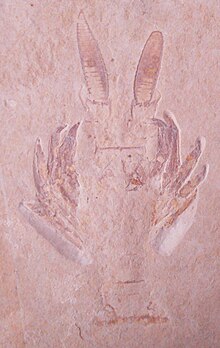Cancrinos

| Cancrinos Temporal range: | |
|---|---|
 | |
| Scientific classification | |
| Domain: | Eukaryota |
| Kingdom: | Animalia |
| Phylum: | Arthropoda |
| Class: | Malacostraca |
| Order: | Decapoda |
| Suborder: | Pleocyemata |
| Family: | †Cancrinidae |
| Genus: | †Cancrinos Münster, 1839 |
| Species: | †C. claviger |
| Binomial name | |
| †Cancrinos claviger Münster, 1839 | |
Cancrinos is a genus of fossil crustaceans closely allied with the slipper lobsters. One species is known, C. claviger from the Jurassic of southern Germany.
Taxonomy
[edit]Fossils of Cancrinos are rare, and their state of preservation is often imperfect.[1] Count Georg zu Münster first described Cancrinos in 1839, based on material from the Upper Jurassic Solnhofen limestones of southern Germany.[2] He described two species, Cancrinos claviger and C. latipes, differentiated by the size of the second antennae,[2] but the two are now considered to be synonyms.[1]
Further specimens have been discovered in Upper Cretaceous lithographic limestones of Lebanon, and described as a new species, C. libanensis;[3] however, Haug et al. (2016) made it the type species of a separate genus Paracancrinos.[4]
Classification
[edit]Although Münster was unable to discern any living relatives of Cancrinos during his original description,[2] Reinhard Förster proposed in 1984 that Cancrinos was a transitional form between spiny lobsters (Palinuridae) and slipper lobsters (Scyllaridae).[5][6]
Description
[edit]Cancrinos differs most markedly from other related animals by the form of the second antennae, which are flattened towards the end, approaching the state seen in living slipper lobsters.[7] Unlike living slipper lobsters, however, the flattened, distal parts of the antennae retain the ancestral state of comprising many segments, rather than being reduced to a single element.[7]
Development
[edit]Because immature specimens have been found, parts of the ontogeny of Cancrinos are known, although it is unclear whether the smallest specimens are in the puerulus stage, or are juveniles.[1] Younger specimens have less flattened antennae, more like those of living spiny lobsters; thus, Canrcinos exhibits a form of heterochrony known as peramorphosis.[7] This ontogeny is thought to reflect the phylogeny of Cancrinos, representing a partial development from the ancestral spiny lobster-like form towards the derived slipper lobster-like form.[7]
References
[edit]- ^ a b c Joachim T. Haug; Carolin Haug; Dieter Waloszed; Andreas Maas; Matthias Wulf; Günter Schweigert (2009). "Development in Mesozoic scyllarids and implications for the evolution of Achelata (Reptantia, Decapoda, Crustacea)" (PDF). Palaeodiversity. 2: 97–110.
- ^ a b c Georg zu Münster (1839). "Cancrinos". Decapoda Macroura. Abbildung und Beschreibung der fossilen langschwänzigen Krebse in den Kalkschiefern von Baiern. Beiträge zur Petrefacten-Kunde. Vol. 2. Bayreuth, Germany. pp. 43–45.
- ^ Alessandro Garassino; Günter Schweigert (2006). "The Upper Jurassic Solnhofen decapod crustacean fauna: review of the types from old descriptions. Part I. Infraorders Astacidea, Thalassinidea, and Palinura". Memorie della Società Italiana di Scienze Naturali e del Museo Civico di Storia Naturale di Milano. 34.
- ^ Joachim T. Haug; Denis Audo; Sylvain Charbonnier; Ferran Palero; Gilles Petit; Pierre Abi Saad; Carolin Haug (2016). "The evolution of a key character, or how to evolve a slipper lobster" (PDF). Arthropod Structure & Development. 45 (2): 97–107. doi:10.1016/j.asd.2015.08.003. PMID 26319267.
- ^ Carolin Haug; Joachim T. Haug; Dieter Waloszek (2009). "Neues zur Krebsfauna der süddeutschen Plattenkalke" [Developments in the crustaceans of the plattenkalks of southern Germany] (PDF). Archaeopteryx (in German). 27: 31–37. Archived from the original (PDF) on 2016-03-03. Retrieved 2012-02-05.
- ^ Reinhard Förster (1984). "Bärenkrebse (Crustacea, Decapoda) aus dem Cenoman des Libanon und dem Eozän Italiens". Mitteilungen der Bayerischen Staatssammlung für Paläontologie und historische Geologie. 24: 57–66.
- ^ a b c d Joachim T. Haug; Carolin Haug; Dieter Waloszek; Günter Schweigert (2011). "The importance of lithographic limestones for revealing ontogenies in fossil crustaceans" (PDF). Swiss Journal of Geosciences. 104 (Suppl. 1): S85–S98. doi:10.1007/s00015-010-0033-1. S2CID 83780274. Archived from the original (PDF) on 2016-06-30. Retrieved 2012-02-05.
External links
[edit] Media related to Cancrinos at Wikimedia Commons
Media related to Cancrinos at Wikimedia Commons

